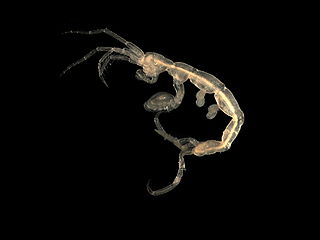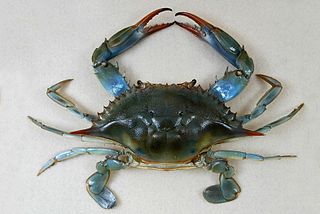
Amphipoda is an order of malacostracan crustaceans with no carapace and generally with laterally compressed bodies. Amphipods range in size from 1 to 340 millimetres and are mostly detritivores or scavengers. There are more than 9,900 amphipod species so far described. They are mostly marine animals, but are found in almost all aquatic environments. Some 1,900 species live in fresh water, and the order also includes the terrestrial sandhoppers such as Talitrus saltator and Arcitalitrus sylvaticus.

Gammaridea is one of the suborders of the order Amphipoda, comprising small, shrimp-like crustaceans. Until recently, in a traditional classification, it encompassed about 7,275 (92%) of the 7,900 species of amphipods described by then, in approximately 1,000 genera, divided among around 125 families. That concept of Gammaridea included almost all freshwater amphipods, while most of the members still were marine.
Hadziidae is a family of amphipods, which is difficult to distinguish from the related family Melitidae. It contains the following genera:

Corophiida is an infraorder of amphipods that contains the two parvorders Caprellidira and Corophiidira.
Melphidippidae is a family of amphipods which rest upside-down and feed on particles of food suspended in the water. Three genera are recognised:
Phliantidae is a family of isopod-like amphipod crustaceans chiefly from the southern hemisphere.
Anisogammaridae is a family of small benthic amphipods, endemic to the northern part of the Pacific rim. The family contains the following genera:

Eumalacostraca is a subclass of crustaceans, containing almost all living malacostracans, or about 40,000 described species. The remaining subclasses are the Phyllocarida and possibly the Hoplocarida. Eumalacostracans have 19 segments. This arrangement is known as the "caridoid facies", a term coined by William Thomas Calman in 1909. The thoracic limbs are jointed and used for swimming or walking. The common ancestor is thought to have had a carapace, and most living species possess one, but it has been lost in some subgroups.
Paracalliopiidae is a family of amphipods, containing the following genera:
Paracrangonyx is a genus of amphipods in the family Paracrangonyctidae, comprising two species, Paracrangonyx compactus and Paracrangonyz winterbourni.

Amaryllididae is a family of marine benthic amphipods found throughout the southern hemisphere. These smooth, laterally compressed amphipods can be distinguished by the accessory setal row of the mandible having a distal tuft. It was first described in 2002 by James K. Lowry and Helen E. Stoddart. It contains the following genera:
Yhi yindi is a species of amphipod crustacean, known only from Orpheus Island, Queensland, Australia. It was described in 1991 by J. Laurens Barnard and J. D. Thomas, and remains the only species in the genus Yhi.

Alicellidae is a family of amphipod crustaceans, which live as scavengers in the deep sea, often in association with hydrothermal vents. The family includes the following genera:

Caprelloidea is a superfamily of marine crustaceans in the order Amphipoda. It includes "untypical" forms of amphipods, such as the skeleton shrimps (Caprellidae) and whale lice (Cyamidae). The group was formerly treated as one of the four amphipod suborders, Caprellidea, but has been moved down to the superfamily rank by Myers & Lowry after phylogenetic studies of the group, and is now contained in the infraorder Corophiida of the suborder Senticaudata. The group includes the following families.

Americorchestia is a genus of beach hoppers in the family Talitridae. There are about five described species in Americorchestia.

Bathyporeiidae is a family of amphipods in the order Amphipoda. There are two genera in Bathyporeiidae:
Bougisia is a genus of plankton in the sub-order Hyperiidea – a type of so-called "hyperid" amphipoda. The genus Bougisia is the only subordinate taxon in the monotypic family Bougisidae. The genus Bougisia is also monotypic, being represented by the single species, Bougisia ornata. This species lives as plankton in tropical and sub-tropical salt water. Hyperiidea species normally have a physique that differs from other types of amphipod.

Eurythenes is a genus of marine amphipods in the family Eurytheneidae.
Iphigenellidae is a freshwater family of amphipods in the superfamily Gammaroidea. It is found in the Ponto-Caspian region, which encompasses the Black, Azov, and Caspian Seas.
Lauren Elizabeth Hughes is an Australian carcinologist and curator. She specialises in the study of amphipods.










